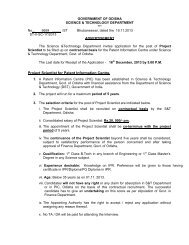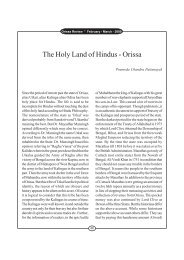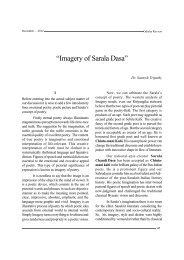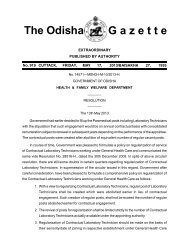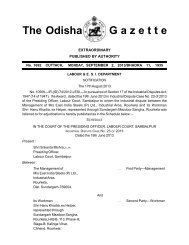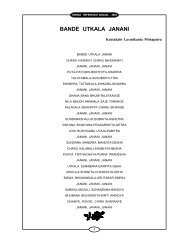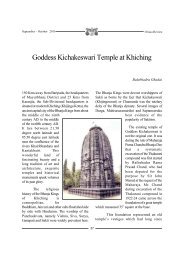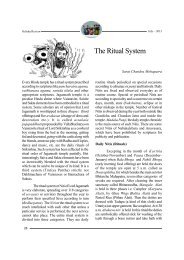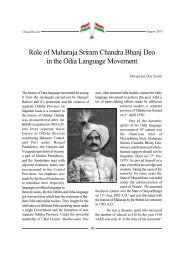Kalinga and Funan : A Study in Ancient Relations
Kalinga and Funan : A Study in Ancient Relations
Kalinga and Funan : A Study in Ancient Relations
You also want an ePaper? Increase the reach of your titles
YUMPU automatically turns print PDFs into web optimized ePapers that Google loves.
Orissa Review<br />
Bhubaneswar <strong>in</strong> Orissa. 21 At the nucleus po<strong>in</strong>t of<br />
the temple st<strong>and</strong>s a svayambhu-l<strong>in</strong>ga, a ‘selfexistent’<br />
manifestation of the god Siva, <strong>in</strong> massive<br />
stone. This ‘self-generated’ image of Siva cannot<br />
be removed from the spot where Siva orig<strong>in</strong>ally<br />
manifested himself. So, dur<strong>in</strong>g the numerous<br />
festivals of Lord L<strong>in</strong>garaja, the function of<br />
‘deputy’ for Siva outside the temple is discharged<br />
by a four-armed bronze sculpture of about 45<br />
cm <strong>in</strong> height, which represents Siva as<br />
Ch<strong>and</strong>rasekhara. 22 Dur<strong>in</strong>g the festivals, this<br />
sculpture is the focus of all those rituals that are<br />
directed to Lord L<strong>in</strong>garaja as “(Siva) L<strong>in</strong>ga which<br />
is the k<strong>in</strong>g”. 23 In an Angkorian <strong>in</strong>scription reference<br />
is made to the worship of devaraja <strong>in</strong> the form<br />
of chalanti pratima. 24 An <strong>in</strong>scription of Kok<br />
Rosei enumerates the endowments made by the<br />
priest Sivacharya, who was presumably the<br />
famous purohita of the devaraja under k<strong>in</strong>gs<br />
Jayavarman V <strong>and</strong> Suryavarman I at the end of<br />
the tenth <strong>and</strong> the beg<strong>in</strong>n<strong>in</strong>g of the eleventh centuries<br />
CE 25 .<br />
However, <strong>in</strong> about the twelfth century<br />
CE, the Saivite ideology had lost its significance<br />
both <strong>in</strong> Cambodia <strong>and</strong> <strong>in</strong> all the states of southern<br />
<strong>and</strong> eastern India <strong>in</strong>clud<strong>in</strong>g <strong>Kal<strong>in</strong>ga</strong>. Saivism as<br />
an ideology of state experienced a crisis. It<br />
happened so perhaps because of the activities of<br />
the Great Vaisnavite reformer Ramanuja. Thus,<br />
at the beg<strong>in</strong>n<strong>in</strong>g of the twelfth century CE, k<strong>in</strong>g<br />
Suryavarman II (c.1113 – 1150 CE) <strong>in</strong> Cambodia<br />
submitted to the allure of Vaisnavism at the same<br />
time as Anantavarman Chodaganga Deva, the<br />
Ganga emperor of Orissa (c. 1112 – 1146 CE),<br />
<strong>in</strong> eastern India. Both gave up the Saivite state<br />
religion of their forefathers <strong>and</strong> built up new<br />
gigantic temples <strong>in</strong> honour of the god Vishnu. So,<br />
on either side of the Bay of Bengal, huge<br />
Vaisnavite temples appeared simultaneously, the<br />
Jagannatha temple at Puri, <strong>in</strong> Orissa, <strong>and</strong> Angkor<br />
Wat <strong>in</strong> Cambodia 26 . In the beg<strong>in</strong>n<strong>in</strong>g years of the<br />
36<br />
November - 2011<br />
sixth century CE, Gunavarman “the moon of the<br />
Kaund<strong>in</strong>ya race” established a sanctuary at Thapmuoi<br />
called Chakratirthasvami (Vishnu temple)<br />
that conta<strong>in</strong>ed the footpr<strong>in</strong>ts of Vishnu 27 . In Orissa,<br />
Puri is known as Chakratirtha <strong>and</strong> Lord<br />
Jagannath is venerated as Chakratirthasvami<br />
(Vishnu).<br />
From the history of <strong>Funan</strong> we also learn<br />
that a second Kaund<strong>in</strong>ya ruled the country <strong>in</strong> the<br />
fourth century CE who enforced H<strong>in</strong>du social <strong>and</strong><br />
religious code with more vigour <strong>and</strong> contributed<br />
greatly for Indianisation of the natives. He changed<br />
all the laws of the country <strong>and</strong> brought them <strong>in</strong><br />
the l<strong>in</strong>e with those prevalent <strong>in</strong> India. Accord<strong>in</strong>g<br />
to H.B. Sarkar 28 this Kaund<strong>in</strong>ya II (an Indian<br />
Brahman) had come to <strong>Funan</strong> from P’an-p’an, a<br />
small state <strong>in</strong> Malay Pen<strong>in</strong>sula which was<br />
dom<strong>in</strong>ated by the Brahm<strong>in</strong>s. These Brahm<strong>in</strong>s <strong>in</strong><br />
the days of yore perhaps went from the coast of<br />
<strong>Kal<strong>in</strong>ga</strong> to the Malaya Pen<strong>in</strong>sula <strong>and</strong> thence to<br />
<strong>Funan</strong> “<strong>in</strong> search of wealth”. To strengthen this<br />
ancient <strong>Funan</strong>-<strong>Kal<strong>in</strong>ga</strong> contact <strong>and</strong> migration of<br />
Kaund<strong>in</strong>ya from <strong>Kal<strong>in</strong>ga</strong>, there is also another<br />
evidence that the river Mekong (Me-khong<br />
accord<strong>in</strong>g to Ptolemy)which flows through the<br />
k<strong>in</strong>gdom of <strong>Funan</strong> was called by the name<br />
‘Mahanadi’, the pr<strong>in</strong>cipal river of Orissa. 29<br />
Mekong , however, was also called Ma-Ganga<br />
(the Mother-Ganga) <strong>in</strong> some places. 30 From this<br />
narration it can be presumed that Mekong played<br />
an important role <strong>in</strong> the history of <strong>Funan</strong><br />
(Kambuja or Cambodia) as Mahanadi <strong>and</strong> Ganga<br />
did <strong>in</strong> the early history <strong>and</strong> civilization of <strong>Kal<strong>in</strong>ga</strong><br />
<strong>and</strong> northern India respectively. Further, the<br />
nam<strong>in</strong>g of such an important river of <strong>Funan</strong> by a<br />
<strong>Kal<strong>in</strong>ga</strong>n name positively <strong>in</strong>dicate emigration of a<br />
large number of <strong>Kal<strong>in</strong>ga</strong> people <strong>in</strong>to that country<br />
<strong>in</strong> ancient days.<br />
The H<strong>in</strong>du K<strong>in</strong>gdom of <strong>Funan</strong> flourished<br />
from the 1 st century CE to the middle of the sixth



